When Leppington train station opened in February 2015, it was regarded as a rare Sydney example of how urban planning should work: build the infrastructure first, then the homes.
But a decade later, it may serve as a warning of what not to do. Far from becoming the “Burwood of the south-west”, as urban planner David White dubbed it at the time, Leppington is still the end of a train line to nowhere.
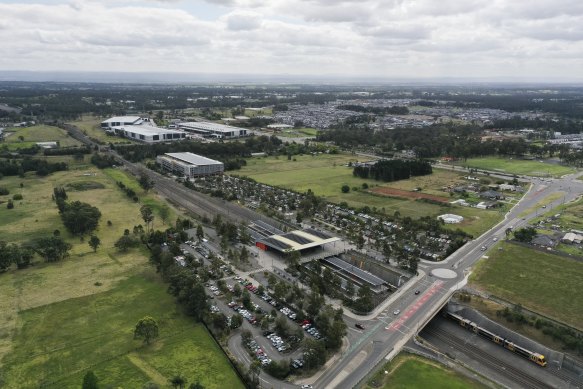
For now, Leppington Town Centre is a train station surrounded by fields.Credit: Rhett Wyman
“It was all based on the ‘build it and they will come’ principle,” says White, who worked at the now-defunct NSW Transport Construction Authority when the South West Rail Link was approved.
These days, he calls Leppington “the south-west struggler”. It is eerily unchanged from when the station opened 10 years ago, except for the Leppington Village shopping centre, which opened last year nearly a kilometre from the station, across an empty field.
It’s a pertinent warning for the state government as it begins its Transport-Oriented Development Program, especially the “accelerated precincts” where state planners have envisaged high-density hubs springing up around metro and heavy rail stations.
Just because you build a train station and rezone the land does not necessarily mean development will follow. Planning does not, ipso facto, yield results.
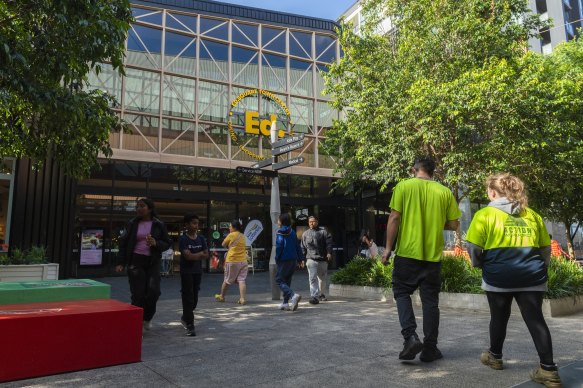
Ed.Square, next to Edmondson Park station, has been a more successful example of transport-oriented development.Credit: Rhett Wyman
But things look rosier in neighbouring Edmondson Park, the other new station on the 11-kilometre train line to Glenfield. Frasers Property won the tender to develop the town centre in 2015; the first stage, the restaurant-packed Ed.Square, is now complete adjacent to the station.
The next stages are also being planned, while state-owned developer Landcom is overseeing civil works north of the train tracks in an area called Precinct 9. It sold part of the precinct to Urban Property Group in December 2021, planned for 600 homes.
This raises a key question: why has one suburb started to succeed while the other hasn’t?
Poor planning
Leppington Town Centre is a 440-hectare precinct (the size of 20 Barangaroos) surrounding the train station. Just over 40 kilometres from Sydney’s CBD as the crow flies, it has been a victim of poor and confused planning from the start.
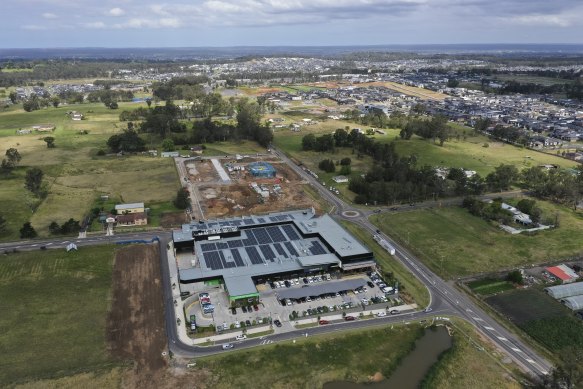
Leppington Village shopping centre opened in 2023, about a kilometre from the train station.Credit: Rhett Wyman
When it was rezoned in 2013, two years before the station opened, it was envisaged as a business park more than a residential precinct. The land between the station and what is now the shopping centre was zoned commercial, surrounded by medium-density housing. Plans said the area would host up to 12,500 jobs and 3000 homes.
But the following year, the federal government finally confirmed Badgerys Creek as the location of Sydney’s second airport. It quickly became clear the future aerotropolis was where commercial and industrial investment would head.
Leppington was left in limbo. Three years later in 2017, the NSW Department of Planning began a review of land zoning in the area. In 2019, it decided to hand planning control over to Camden and Liverpool councils. “They started again,” White says.
Camden took the lead and, after consultation, assembled a draft plan for the town centre in 2022. But under planning protocol, it had to go back to the department for assessment. It only went on public exhibition over the summer of 2023-24, and is yet to be endorsed or finalised.
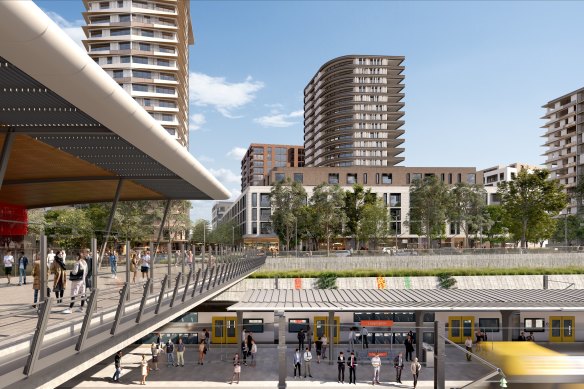
An artist impression of what Camden and Liverpool City councils think Leppington Town Centre will look like by 2041.
Nathan Hagarty, the Labor state MP for Leppington, says the suburb is “probably another victim of the planning system in NSW”, on top of a confluence of other problems. “Everyone wants it to be a success,” he says. “We really need stuff to come out of the ground here.”
Fragmented ownership
Partly due to the zoning dilemma, land in Leppington Town Centre remains under disparate ownership. According to an October 2023 council document, the portion controlled by Camden Council contains 181 land parcels under 123 different owners, including state agencies. The Liverpool City Council portion contains 193 parcels under 169 unique owners or agencies.
Without consolidation, it is difficult to develop. While most of the state government’s transport-oriented development sites across Sydney are in built-up areas quite different from semi-rural Leppington, they may face the same problem: they rely on landowners coming together and agreeing to sell.
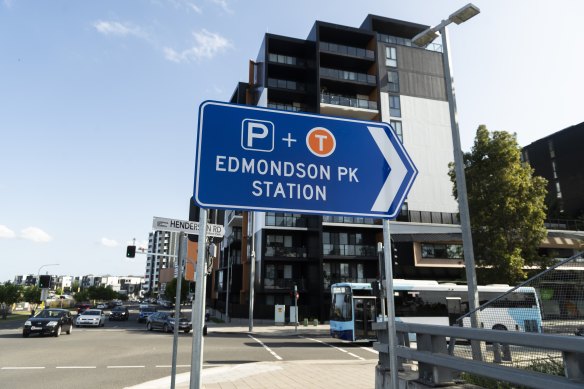
The deal for Frasers Property to develop Edmondson Park was put together by the state government agency Landcom.Credit: Rhett Wyman
White, the former government planner, says a key difference between Leppington and the more successful Edmondson Park is that, in the latter, state-owned developer Landcom stitched together deals such as the major sale to Frasers for the town centre.
“As soon as Landcom get involved, they just seem to have that ability to drive things forward,” he says. “No one really took ownership of Leppington. Transport were like, ‘We’ve done our work, we are out of there’. Planning had a go and flipped it to Camden [Council].”
The NSW Department of Planning agreed with all the aforementioned reasons. “Development has not occurred across the area due to fragmentation of land ownership, lack of a lead developer to establish a town centre, development uncertainty and project feasibility relating to land value expectations and development standards,” it said in a statement.
White acknowledges town centres are notoriously difficult. Even at inner-city Green Square, where the airport rail link opened in 2000, it took 15 years for work to start on the first apartment building.
So it’s not unusual, but it’s not ideal.
“Typically, when you do these things, you want the [town] centre to be there on day one,” White says. “You really do.”
Waiting game
During the pandemic, Naim Safi moved from Surry Hills to Denham Court, next to Leppington, ditching corporate life to become a small-business owner. He has opened two Bowers + Flowers florists in the area, including one at the new Leppington Village shopping centre.
It was a big change and a significant financial investment, one which he’s still hoping will prove worthwhile. But now with higher interest rates and lower spending – and a new city, “Bradfield”, planned at the aerotropolis – Safi is worried Leppington will be left behind.
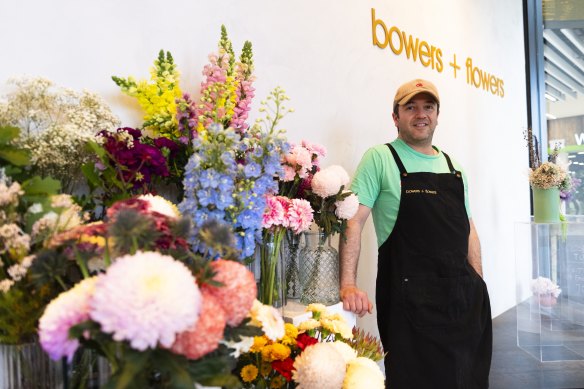
Florist Naim Safi moved from Surry Hills to Denham Court during the pandemic. He has opened a branch of his business in Leppington Village.Credit: Rhett Wyman
“Everybody who invested here is feeling the pinch,” he says. “Everybody assumed the pace of the development and the pace of the transformation would have been faster. Now the big concern is everybody is putting the big bucks in Bradfield.”
It’s not all dire in Leppington. The new council-led plan for the town centre, if adopted, will shift zoning in favour of high-density residential, along with mixed-use near the station and medium-density housing further afield.
Developer ALAND has lodged early plans for a civic centre next to the station that would contain 461 apartments in eight towers, along with shops. In a glossy brochure, chief executive George Tadrosse foresees “a truly magnetic destination” that will kickstart Leppington’s growth.
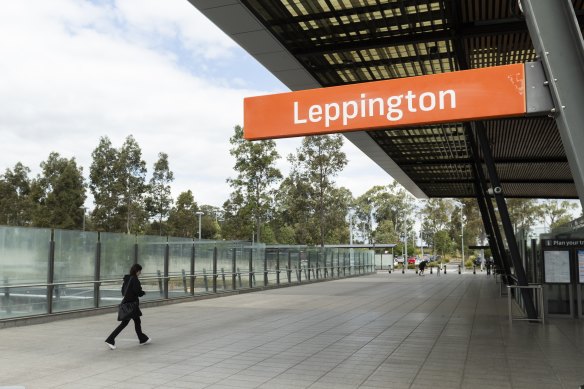
A new plan for Leppington Town Centre has been drafted by Camden and Liverpool councils, but is yet to be endorsed.Credit: Rhett Wyman
The brochure, produced by consultant Hoyne, says Leppington should not be cast as “transport-oriented development”, which often means plonking high-rises around a train station, but as a “transport-enhanced neighbourhood”, with an emphasis on amenity and community.
In July, another company, Byron Development, linked to Chinese-backed developer Apex Property International, lodged plans to build 296 apartments across four buildings on Byron Road, having previously withdrawn proposals for 368 units (in 2020) and 312 (in 2021).
“They’re ready to go as soon as [the master plan] is gazetted,” Hagarty, the state MP, says of various developments. “There’s no shortage of people wanting to live here. It will be a great community, it’s obviously just taking a little longer than was initially planned.”
The NSW Planning Department said it was working with the two councils on the town centre rezoning. It was due for completion by February, but the councils have asked for a one-month extension.
Business owners like Safi can’t wait forever. “We’re all stuck and we’ll have to hope that things will change,” he says. “But it’s not easy.”
Start the day with a summary of the day’s most important and interesting stories, analysis and insights. Sign up for our Morning Edition newsletter.